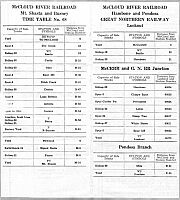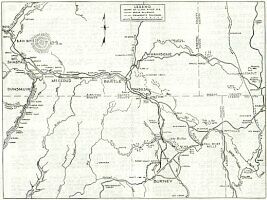

Cover |

Station List |

Map |
|
RULE G: Rule G is amended to read as follows: The use of intoxicants or narcotics by employees subject to duty, or their possession or use while on duty, is prohibited. RULE M: Employees are hereby warned that various structures in the McCLOUD yard will not clear a man on side of car or on top of car. These impairments are indicated by appropriate signs, and where so indicated, engines or cars must be brought to full stop before entering structure and trainmen are prohibited from riding cars into or out of such structure. RULE 1: Standard clock is located at McCLOUD. Bulletin boards are located in dispatcher's office, McCLOUD. Pacific Standard Time is in effect on all lines operated by this Company.
RULE 4(B):
The following are maximum speed limits for the districts shown:
Speed must be held under the above limits when necessary in the judgment of the conductor or engineer, or on account of weather, track conditions, or nature of loads in the train, or when prescribed by bulletin, slow order, or slow boards. Speed of trains containing straight-side loads of logs must not exceed 25 miles per hour at any point. RULE 9: Night signals will not be displayed under conditions which would create a fire hazard. Day signals displayed at night will be considered as night signals. RULE 19 : Engines at rear of trains between McCloud and Mount Shasta and engines running light will not be governed by Rule 19. Engines at rear of trains will have headlights displayed to the rear. Engines running light will have front and rear headlights displayed.
RULE 31:
The whistle must be sounded at all places where required by rule or law, or to
prevent accidents. Engine whistle signal 14(l) must be sounded for every public
crossing at grade, except when train or engine is brought to a stop before
reaching such crossing and flagged across.
|
Whistle signal 14(l) will be sounded on approaching
track gangs at work, and at other points other than public crossings for which
whistle posts have been installed.
Whistle signal 14(l) will be sounded by engineers of trains operating flangers, to call attention of flanger operators to locations of switches, frogs, crossing planks, or other obstructions. RULE 72: Westward trains are superior to trains of the same class in the opposite direction RULE 73: Motor cars are inferior to extra trains in both class and direction.
RULE 93:
Yard limits have been established as follows:
RULES 93 and 99:
Trains stopped within yard limits will not protect against approaching trains,
except when necessary in the judgement of the conductor or engineer.
Responsibility for having train under control when approaching yard limits,
expecting to find main track obstructed and prepared to stop short of
obstruction, is placed upon the approaching train.
RULE 103: When switching over public crossings at grade, a member of the crew must protect the crossing, except when engine is in the lead. TRAIN MOVEMENTS - Trains moving under conditions that may require them to stop must, where possible, stop to clear public grade crossings. When not possible to stop clear of such crossings and train cannot proceed immediately, crews on other than passenger trains must cut these crossings within 10 minutes unless no vehicles are waiting at or closely approaching the crossing. Public crossings must be left open until it is known that trains are ready to depart. Crews required to pick up, set out or perform switching operations must, when track room exists, stop their trains back a sufficient distance to avoid blocking public crossings when coupling trains and while charging train lines. When recoupling at public crossings, trains shall be moved promptly consistent with safety.
SWITCHING MOVEMENTS -
Switching movements over public grade crossings should be avoided whenever
possible.
GRADE CROSSING PROTECTION CIRCUITS - Cars or locomotives must not be left standing nor switches left open within the controlling circuits of automatic gate protection devices unless timeout features are provided to allow the gate arms to rise.
RULE 104:
Crews working in immediate vicinity of main line switches, McCLOUD yard, may
leave such switches lined for leads and side tracks as necessary, and adjacent
derailers in non-derailing position, but when this is done switches must be
secured by open lock in handle hasp. Other crews must approach main line
switches expecting to find them lined for leads and side tracks, and after
using must leave them as found. Yard crews on leaving McCloud yard, or when
tying up for
|
|
meals or at end of day, must leave all main line switches lined for main line,
and locked, and adjacent derailers in derailing position.
Nomal position of junction switch, McCLOUD, will be for Mount Shasta line. Normal position for junction switch at Obie will be lined for Burney. There will be no normal position for junction switch at Bartle. When target is green, switch will be lined for Burney. RULE 104(B): Centralized traffic control is in effect on Southern Pacific main and passing tracks at Mount Shasta, including turnouts leading therefrom. All McCloud River Railroad Company employees operating in the Mount Shasta yard will be required to pass Southern Pacific Company examinations on centralized traffic control rules. Circuits governing CTC controlled tracks must not be fouled without prior permission from Southern Pacific Company dispatcher. RULE 201: High-Rail cars and all track cars will be operated under clearance orders. Red tail lights or red lantern will be displayed to the rear after sunset and will serve as markers. White indicators will not be displayed. RULE 206: Track motor cars will be designated by prefix "M/W," rail cars by "R/C."
RULE 825:
At McCloud, on west yard and machine shop tracks, hand brakes will be set as
follows: On six cars or less left coupled, all hand brakes; on more than six
cars left coupled, not less than half the total number of hand brakes in each
cut left coupled, to be so distributed that there will be at least two hand
brakes set in the center of cut, at least two on the upper end and the greater
proportion, but not less than two, on the downgrade end. Any employee releasing
any of these brakes must set as many others to replace them.
|
When switching on east yard Shed Tracks Rip 6, 1,
2, 3, 4 and 6, McCloud, cars or cuts of cars to be stopped must be shoved to a
full stop with engine attached, and hand brakes secured before engine is cut
off. Reliance must not be placed on hand brakes to control moving cars or cuts
of cars on these tracks.
RULE 827: Running inspection will be made of all trains leaving Mount Shasta, McCloud, Lookout and Burney. RULE 833: Loaders, or engines in rental service operating under trackage rights or tariff provisions, will be moved over the tracks of this company only under regular clearance orders. RULE 869: A Trainman is required to ride the HEAD DIESEL between stations, unless excused by the Engineer or Conductor.
RULE 921:
Clearance orders will be transmitted by radio, using the same rules and
repeating as by telephone. If there is a radio failure crews will stop at
nearest telephone and report to dispatcher. If radio is to be left unattended
in either mobile or Engines, operator will check out, and check in when he
returns. To conform with FCC regulations, it will be necessary when calling
dispatcher to use call letters . . KAU 988 or KAU 989. When completing a
transmission, KE 8183 is to be given.
RULE 952: No employe shall knowingly transmit any false distress communication, any unnecessary, irrelevant or unidentified communication, nor utter any obscene, indecent, or profane language via radio. RULE 954: Before transmitting, any employe operating a radio transmitting set shall listen a sufficient interval to be sure that the circuit is not already in use, particularly for distress traffic. RULE 956: The railroad company is required to answer an official notice of violation of the terms of the Communications Act of 1934, as amended, within ten days from receipt of notice and any employe receiving inquiry concerning any violation shall answer such inquiry within 48 hours after receipt of notice. RULE 962: Radio communication system may be used in lieu of hand, flag or lamp signals prescribed by Rule 12 when such signals cannot be passed to engineer. When movement is being controlled by use of radio, continuous voice transmission must be maintained, using train or engine identification in conjunc- tion with the signal; and movement must be made with caution. Failure of engineer to receive continuous voice transmission must be construed as a stop signal.
Southern Pacific Company's Air Brake Rules and Regulations governing train handling, operation and tests of air brake and el signal apparatus, effective February 1, 1939, or reissues thereof, are in effect on lines operated by this Company, except insofar as they apply to equipment not used on such lines. Employees are required to familiarize themselves with, and be governed by, these rules. RULE 2: Brake pipe pressure of 80 lbs. will be maintained on freight and mixed trains. RULE 17: On descending grades retainers will be used when necessary in judgment of conductor and engineer.
RULE 24(b):
Rear end tests will be made as prescribed by Air Brake Rule 24(b) at all
originating points where trains are made up. See rule 24(c) for tests at other
points.
|
Return to the Western Rails HOME page
This page was created on January 9, 2001 and revised on December 27, 2001